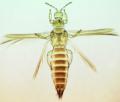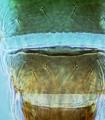Thrips australis
Recognition data
Distinguishing features
Both sexes fully winged. Body variable, often yellow with brown area medially on tergites II–IX, segment X brown; some females more extensively dark brown, also many females extensively pale; antennal segment I white, III yellow, remaining segments largely brown; fore wings pale with dark setae, hind margin shaded. Head wider than long; two pairs of ocellar setae; pair III arising just within anterior margins of ocellar triangle close to fore ocellus; postocular setae pairs I & III as long as ocellar setae pair III. Antennae 7-segmented; segments III–IV slightly constricted at apex with short forked sensorium; segment VII short, VI bullet-shaped. Pronotum with 2 pairs of short stout posteroangular setae; posterior margin with 3 pairs of setae. Metanotum reticulate medially; median setae arising well behind anterior margin; campaniform sensilla present. Fore wing first and second veins with almost complete row of closely set setae; clavus with 6 marginal setae. Abdominal tergite II with 4 lateral marginal setae, the two anterior setae equal in length; tergites V–VIII with paired ctenidia, on VIII posteromesad to spiracles; tergite VIII posterior margin with comb incomplete medially, about eight teeth laterally; pleurotergites commonly with more than 5 discal setae. Sternite II with 2 pairs of marginal setae, III–VII with 3 pairs. Sternites with many discal setae, 3 on sternite II but 30 on sternite VII, in irregular double rows.
Male smaller and paler than female; tergite VIII with no comb; sternites III–VII with small transverse pore plate anterior to about 10 discal setae.
Variation
This species is highly variable in size and color, from large and generally brown to small and almost white.
Related and similar species
The genus Thrips is the second largest genus in the Thysanoptera, and currently includes, worldwide, about 285 species. T. australis differs from Holarctic species of this genus in having six (or even seven) veinal setae on the clavus of the fore wing, rather than the usual number of five (or four). Some European workers therefore place this species in a separate genus, Isoneurothrips, but a similar condition occurs in several African species of genus Thrips. All members of Thrips lack ocellar setae I on the head, and they all have ctenidia on tergite VIII posteromesad to the spiracles. Other characters, such as number of antennal segments, number of setae on the fore wing veins, and number of discal setae on the sternites are variable between species (Palmer, 1992; Nakahara, 1994; Mound & Masumoto, 2005).
Taxonomic data
Current valid name
Thrips australis (Bagnall)
Original name and synonyms
- Isoneurothrips australis Bagnall, 1915: 592
- Thrips lacteicorpus Girault, 1926: 17
- Thrips mediolineus Girault, 1926: 18
- Anomalothrips amygdali Morgan, 1929: 5
- Isoneurothrips marisabelae Ortiz, 1973: 119
Family placement
Thripidae, Thripinae
Common names
Australian gum tree flower thrips
Biological data
Life history
Breeding in flowers
Host plants
Eucalyptus species with white flowers, also other Myrtaceae
Tospoviruses vectored
None
Crop damage
None
Distribution data
Area of origin
Australia
Distribution
Australia, but now widespread in areas around the world where Eucalyptus trees are grown, including countries in Africa as well as South and North America, including California.









